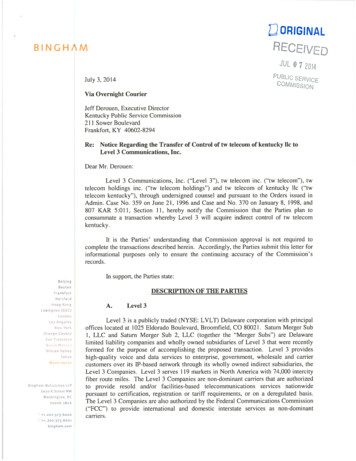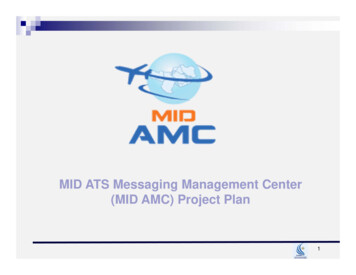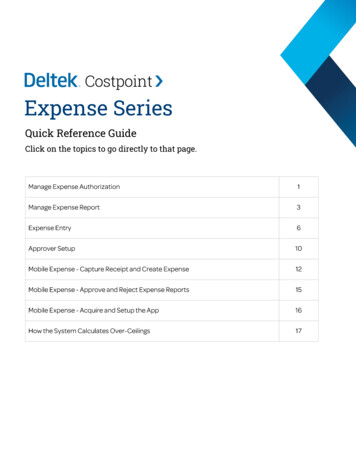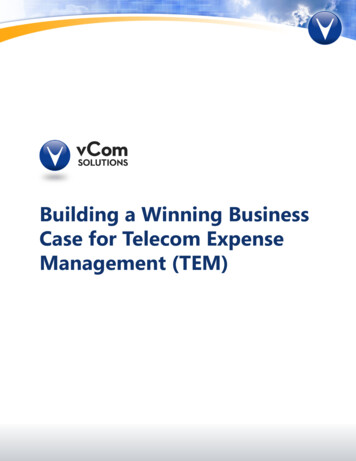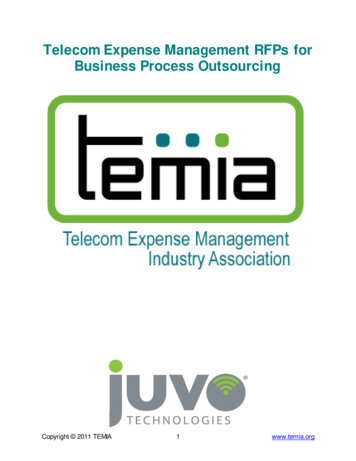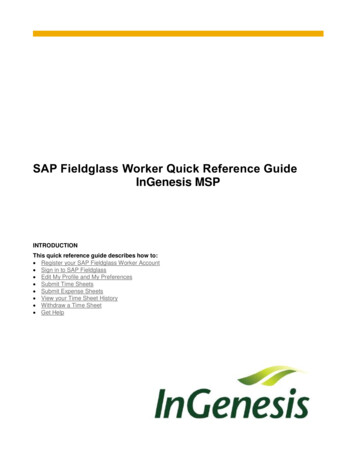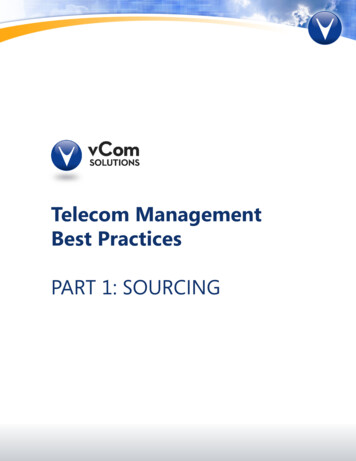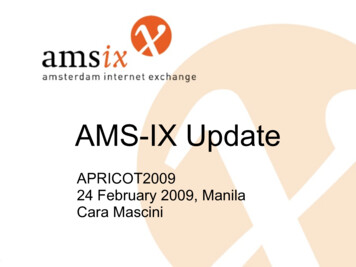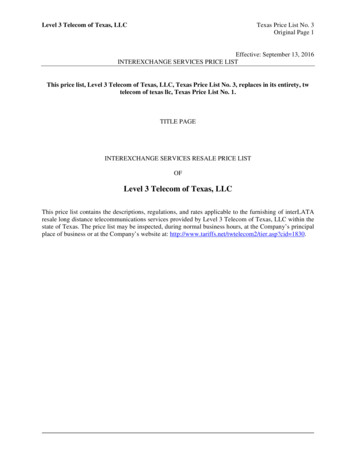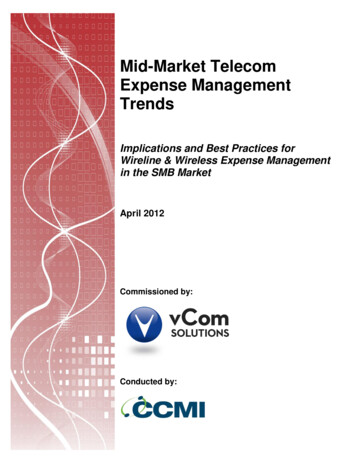
Transcription
Mid-Market TelecomExpense ManagementTrendsImplications and Best Practices forWireline & Wireless Expense Managementin the SMB MarketApril 2012Commissioned by:Conducted by:
Research Report: Implications and Best Practices for Wireline & Wireless Expense Management in the SMB MarketMid-Market Telecom Expense Management TrendsSurvey reveals Catch-22 for small and medium-sized businesses (SMBs) needing to manage networkservice levels, inventory and spend.Executive Summary: The State of SMB Communications ManagementSmall and medium-sized businesses (SMBs) can find themselves between a rock and a hard place whennegotiating with multiple communications carriers, attempting to maintain service levels and manage theirtelecom expenses. Many, according to a recent survey conducted by CCMI on behalf of vCom Solutions, arelarge enough to be working with multiple network service providers and are processing dozens of disparatetelecom invoices each month. Yet they are often too budget-constrained to have in-house telecom staffdedicated to managing carrier relationships and auditing bills or to hire experts with the skill sets needed tooperate on-site automated telecom and wireless expense management (TEM/WEM) systems (see Figure 1).What are the top 3 challenges you face in sourcing, procuringand tracking telecom?Negotiating multiple contracts45%Having the right technical skills in house43%Managing multiple carriers34%Lack of unbiased sources of information30%Coordinating installations with multiple carriers30%Managing the test and turn-up process30%Limited visibility into technical details on services28%Lack of experience in sourcing telecom25%Insufficient or no tracking tool for inventoryInsufficient or no resources to manage24%11%Figure 1. SMBs say their top telecom challenges are juggling multiple carriers and contracts and maintaining the appropriatetechnical skills in house. The percentages shown reflect how many respondents named each challenge as one of their topthree.The unintended outcome for some companies? Suboptimal negotiated contract terms and rates and inefficientasset and inventory tracking. In other words, many are spending more than they would need to if they had areliable, automated way of seeing their big-picture spend and processing invoices.» Growing ComplexityThis issue has grown more common with the explosion of mobility and wireless services. SMBs, like otherorganizations, usually have to manage wireline and wireless network services, invoices and carriersseparately. The process has become administratively complex for everyone, but especially so for those withsmall staffs. 2012 CCMI and vCom Solutions. All Rights Reserved.Page 2
Research Report: Implications and Best Practices for Wireline & Wireless Expense Management in the SMB MarketAnd as SMBs grow and expand to multiple sites, they are likely to use even larger numbers of network serviceproviders. One survey participant who idealistically responded when asked how his procurement andnegotiation process could improve probably echoed the thoughts of many SMBs: “If carriers expanded serviceareas to all our locations we wouldn't have to use several different ones.”That, indeed, would be a big help: As the number of providers, plans and invoices exponentially grows, usingbasic tools such as off-the-shelf spreadsheets and databases to track inventory, audit bills and manage costsbecomes far less scalable, comprehensive and effective.» Need for Automated ToolsConsider, for example, Monterey Mushrooms, Inc., the U.S.’s largest producer of fresh mushrooms. Thecompany is headquartered in Watsonville, Calif., but runs nine farms throughout the country and maintainsoffices in Mexico, Canada and France, as well. So the company uses a variety of local network serviceoperators.When director of information systems Mike Matelli was asked to perform an accounting on the company’swired and wireless voice and data spend several years ago, “it took about five years for me to get a handle onabout 70% of it,” he says. The company, which at the time was processing more than 100 network serviceinvoices each month, doesn’t employ a telecom person per se; Matelli went about gathering the informationusing a Microsoft Access database and manually tracking down invoices and investigating charges, heexplains.While many organizations feel Matelli’s pain, there are operator aggregation services and cloud-basedexpense and inventory management services emerging to ease the burden. As these offerings becomeparticularly affordable thanks to the trend toward software-as-a-service (SaaS) cloud computing models, once“forgotten” SMBs such as Monterey Mushrooms can gain better control over their expenses and service levels.Key Survey FindingsCCMI’s recent survey of 100 companies with revenues ranging from 25 million to 500 million reflect thegrowing complexity and SMB burden Matelli experienced in network service procurement and expensemanagement several years ago. Here is a summary of the study’s findings:»There are lots of disparate invoices for SMBs to process, audit and analyze. 42% of SMBssurveyed process more than 10 wireline and wireless invoices each month, and 4% process more than25. These situations can make it difficult to determine overall spend and spot opportunities for costreduction.»SMBs increasingly are working with more service providers. More than a fifth (21%) surveyed workwith six or more wireline network service providers. And nearly a third (32%) surveyed work with threeor more wireless network service providers. All, of course, have their own invoicing formats and codes,making aggregation and analysis challenging at best.»A substantial number of SMBs suspect they might not be getting the biggest bang for theirtelecom buck. For example, 41% said they are unsure as to whether they are getting the best networkservice deals possible for their organizations. And well over half (62%) think there’s more they can doto better control their telecom expenses.»Wireless spend has caught up with wireline spend. And both expenses are substantially risingfor more than a third of respondents. More than a third of the respondents (36%) said their wirelinespending increased by more than 10% in 2011 compared with 2010; the same percentage (36%) saidtheir wireless spend increased by more than 10%, too. 2012 CCMI and vCom Solutions. All Rights Reserved.Page 3
Research Report: Implications and Best Practices for Wireline & Wireless Expense Management in the SMB Market»Relatively few SMBs use automated tools for expense tracking and management. Just 9% ofrespondents use a third-party expense-management tool; the majority use off-the-shelf spreadsheetand databases to track costs.The complexity facing SMBs, reflected in these findings, is driving the demand for more powerful (yet simple)tools and services that companies focused on their core business – not on telecommunications – can use tonegotiate and track charges more efficiently than they typically have been able to do.Time to Dump Excel?The majority of survey respondents (69%) said they use an off-the-shelf spreadsheet (such as Microsoft Excel)or off-the-shelf database (such as Microsoft Access) to track their wired and wireless telecom expenses. Thegood news here is that most organizations are at least making an effort to track expenses: only 2% said theyweren’t tracking expenses at all. Another 2% admitted that they weren’t sure whether they were doing so or not(see Figure 2).What kind of tools/software do you use for tracking yourtelecom expenses?Third-partyCustom programdeveloped inhouse18%Microsoft Accessor similardatabase program28%Microsoft Excel ution9%Don't know2%We don't trackour telecomexpenses2%Figure 2. Most respondents are using fairly rudimentary and labor-intensive methods of tracking telecom expenses.The less stellar news is that the tools most commonly used by SMBs are growing inadequate to match thecomplexity of their telecom situations. Increasingly necessary is the ability to see expenses in an aggregatedfashion and the ability to strike apples-to-apples comparisons across plans and providers.The SMBs surveyed indicated an awareness of automated tools available for this function; however, they hadvarious reasons why they had not implemented them to date. Among their reasons were cost concerns,constraints on available time to research and deploy them, a dearth of choices they deemed appropriate forSMBs and a general lack of support by upper management to purchase and deploy automated tools (seeFigure 3). 2012 CCMI and vCom Solutions. All Rights Reserved.Page 4
Research Report: Implications and Best Practices for Wireline & Wireless Expense Management in the SMB MarketIf you have considered a telecom expense management (TEM) solution, buthave not yet implemented one, what are the barriers to doing so?Too costly35%Don’t have time to research my options31%Unable to find a solution that meets the needs of an SMB27%I have never considered implementing a TEM solution21%Don’t have time to go through a procurement process18%Don’t have upper-management approval to purchase asolution16%Figure 3. SMBs that aren’t using automated tools for telecom expense tracking and management cite time and money as theprimary reasons. However, it’s possible that the dollars being lost in inefficient telecom contracts, billing errors andadministration could easily pay for the use of modern-day expense management tools – and then some.Still, many did say they have other initiatives under way to control wireline expenses, such as replacing T1 andISDN lines with less expensive Session Initiation Protocol (SIP) trunking services and leaving room in theirtelecom contracts to regularly review pricing (see Figure 4).What initiatives do you currently have underway to manage and control yourwireline expenses?50%46%35%26%15%Use of newertechnology, likeSIP trunkingUse of a telecomexpensemanagementsolutionContract clausesthat allow forperiodic ratereviewsEncouragetelecommutingNoneFigure 4. The SMBs wising up to the need to curb diverse and hard-to-track telecom bills are using a smattering of methods todo so. 2012 CCMI and vCom Solutions. All Rights Reserved.Page 5
Research Report: Implications and Best Practices for Wireline & Wireless Expense Management in the SMB MarketWireless: Another Moving Part to ManageThe explosion of cellular services has only exacerbated the fragmentation problem associated with controllingcommunications services and their associated costs. Defying logic, the large carriers that sell both landline andcellular services insist on creating separate packages and contracts for the wireless voice and data servicesbucket and the terrestrial services bucket. Not only that: there’s the employee-liable, “bring your own device”(BYOD) trend raging through organizations that threatens to further diminish corporate control over mobilenetwork usage and behavior.What are the top 3 challenges you face in wireless device management?Inventory and asset management58%Ongoing device on deployment and security compliance54%Plan optimization49%Managing employee liable devices (BYOD)Device procurement48%34%Figure 5. The trend toward letting employees bring their personal devices to work for network access is creating a movingtarget for SMBs trying to manage their inventory and assets, deploy mobile apps and remain compliant with security policies.The percentages shown reflect how many respondents named each challenge as one of their top three.Managing inventory and assets ranked at the top of wireless management challenges cited by surveyrespondents (see Figure 5 above). On the other hand, most of the SMBs surveyed for this report were shownto have the fundamental, organizational policies in place needed to tame the situation. Only 9% said they hadno initiatives under way to manage and control their wireless expenses. And most had some combination ofother processes in place to curb runaway costs (see Figure 6). 2012 CCMI and vCom Solutions. All Rights Reserved.Page 6
Research Report: Implications and Best Practices for Wireline & Wireless Expense Management in the SMB MarketWhat initiatives do you currently have underway to manage andcontrol your wireless expenses?Limit who is eligible for mobile device usage58%Strict usage policy and enforcement50%Use of a telecom expense management solution35%Limit minutes and data usage27%Use of a policy-driven mobile device managementsystem25%Only issue corporate-liable devices20%NoneUse prepaid devices9%1%Figure 6. SMBs are instituting a variety of policies and other initiatives to curb escalating wireless expenses. Respondentscould choose as many initiatives as were applicable.A quarter of respondents had deployed or were in the process of employing a policy-driven mobile devicemanagement (MDM) system, which can take automated action to limit usage, say, when a user roams off ahome network. Such systems generally require a client agent on the employee devices, which is a strongalternative if the SMB issues the devices itself (a “corporate-liable” model) and has the expertise to install theclient software and run the MDM system. And these systems can also address the other challenges shown inFigure 5, including managing mobile application deployment, security compliance and device procurement andretirement.Not surprisingly, tracking mobile devices and associated usage and chargeback was the thorniest challengewhen it came to managing wireless expenses (see Figure 7).What are the top 3 challenges you face in wireless expensemanagement?57%51%37%Trackingdevices andassociatedcommitmentsand utilization35%34%30%29%25%Tying charges Having to code Cost ck toinvoicesand APauditingspending trends pooled minute different invoiceemployees,manuallyintegrationexpenses (e.g.,plansformats fromdepartments oroverages, outdifferent carrierscost centersof-use devices,etc.)Figure 7. The most difficult aspects of managing wireless expenses, SMBs say, are tracking devices and their associatedcommitments and utilization, then charging back the costs. The percentages shown reflect how many respondents namedeach challenge as one of their top three. 2012 CCMI and vCom Solutions. All Rights Reserved.Page 7
Research Report: Implications and Best Practices for Wireline & Wireless Expense Management in the SMB MarketConclusion and Recommendations for SMBsSMBs now rival their larger enterprise counterparts in their need to get a firm grasp of their wired and wirelesstelecom assets, devices and expenses. They tend to have fewer human resources to devote to such tasks,however, and fewer budget dollars to put toward on-site management tools. On the bright side, however, otherstrong options are emerging for these companies to use.Using a managed communications service provider that purchases services wholesale from multiple providersat the back end, for example, streamlines the job of carrier relationship management. As with selecting anymanaged service provider, speaking with several customer references should be a key step in the decisionprocess.The other boon to SMBs is the growing availability of SaaS cloud alternatives both for telecom expensemanagement (wired and wireless) and mobile device management (MDM) and security. In such cases, thesetup usually involves a Web portal, which SMBs can access to see the status of their inventory, expenses andpolicy settings in a common, comprehensive format across the various carriers and services. Economically,SaaS options are attractive for companies on tight budgets because they require no upfront capital outlay forhardware or software; companies pay as they go, based either on a percent of total spend or a flat monthly fee.Some companies provide multiple services – network service aggregation and TEM/WEM SaaS, for example.There are a number of existing and emerging models for getting these tools and capabilities. For example, it’spossible to get SaaS capabilities from managed service providers that provide the software as a value-add.This type of service is rare, but available, so do the homework. It pays for SMBs to collapse as many functionsas possible with a single provider into a common portal, so long as the provider they choose is a highlyreputable and financially sound supplier.Advises Monterey Mushrooms’ Matelli: “Whether you have one or a thousand lines, you have to deal withbilling, service and integration with whatever phone system you have. You might feel you have a good handleon the billing part; the troubleshooting and service, you might not be prepared to deal with.” That’s anotherlevel of support he’s able to get with his provider, he explains, and a reason he is currently in the process ofadding Multiprotocol Label Switching (MPLS) data services to his managed service program. 2012 CCMI and vCom Solutions. All Rights Reserved.Page 8
Research Report: Implications and Best Practices for Wireline & Wireless Expense Management in the SMB MarketAbout vCom SolutionsvCom Solutions revolutionizes the way enterprises manage their entire telecom lifecycle. vCom customers gaincontrol over inventory, expenses and carrier relationships, achieving better business intelligence that drivesprofitability. vCom’s Telecom Management as a Service (TMaaS) solution includes a suite of cloud-basedtelecom management software tools, complemented by a full portfolio of professional services. For moreinformation, visit http://www.vcomsolutions.com.About CCMICCMI is the industry’s leading provider of telecom rate and data solutions and information. We arededicated to delivering relevant, highly specialized and strategically focused content. Find a completeproduct listing at http://www.ccmi.com/Products. CCMI publishes Voice Report, the leading independentsource of telecom news, analysis and award-winning guidance on communications technology servicesand equipment for the enterprise. For analysis and guidance on the latest telecom happenings, visithttp://www.TheVoiceReport.com, and sign up to receive email updates.About Joanie Wexler, Contributing EditorJoanie Wexler is an independent editor and analyst in Silicon Valley, Calif., who has spent 20 years analyzingtrends and news in the computer networking industry. She covers the gamut of IT hot topics, including dataand voice network services and equipment, convergence, wireless communications and data center trends.Contact Joanie at joanie@jwexler.com 2012 CCMI and vCom Solutions. All Rights Reserved.Page 9
SMBs that aren't using automated tools for telecom expense tracking and management cite time and money as the primary reasons. However, it's possible that the dollars being lost in inefficient telecom contracts, billing errors and administration could easily pay for the use of modern-day expense management tools - and then some.
